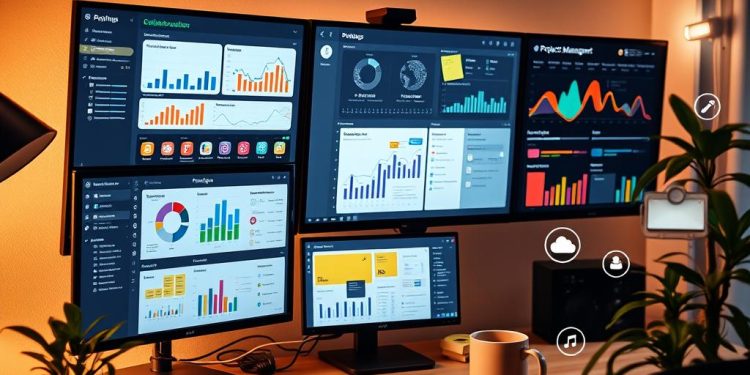In 2025, the digital landscape demands that your business harness the power of website analytics tools to thrive. The best analytics tools enable you to gain real-time data insights that are critical for optimizing user experiences and boosting conversions. Understanding user behavior analytics has become essential for achieving your business goals. This article dives into the must-have features of real-time analytics tools and compares top platforms like Google Analytics and Adobe Analytics Cloud. By selecting the right tools for website performance tracking, you can refine your strategies and make informed, data-driven decisions. Enhancing your ability to monitor and analyze real-time data will undoubtedly position your business for success.
Introduction to Website Analytics in 2025
In 2025, website analytics has undergone significant transformation, making it more sophisticated and user-friendly. Open-source tools have surged in popularity, providing affordable solutions for businesses of all sizes. These analytics platforms empower organizations to gather crucial insights into user engagement, traffic sources, and conversion rates, which are vital for performance optimization.
The reliance on real-time data has become paramount as businesses shift towards data-driven strategies. Understanding website metrics not only enhances operational efficiency but also improves decision-making processes. Notable platforms such as Google Analytics and Matomo lead the way, offering powerful features for comprehensive analysis and reporting.
Various tools available today, such as Hotjar and Crazy Egg, greatly assist in analyzing user behavior through innovative features like heat maps and session replays. These functionalities help you grasp user interaction patterns, determining elements that resonate with your audience. With platforms like VWO Insights and Google Optimize, identifying conversion opportunities and customizing user experiences have never been easier.
As the landscape of website analytics evolves, integrating tools like Clickmeter and Segment facilitates deeper insights into marketing effectiveness and customer data unification, respectively. The continuous advancements in analytics technologies ensure businesses can leverage real-time data to enhance user engagement and drive successful outcomes.
Importance of Real-Time Data for Website Monitoring
Real-time data serves as a vital component for effective website monitoring. With the ability to observe your website’s performance instantly, you can tackle issues as they arise, which enhances overall functionality. Understanding user behavior tracking in real-time enables businesses to manage traffic spikes effectively, ensuring a seamless experience for visitors. This capability empowers you to react swiftly to emerging trends, refine marketing strategies, and optimize user engagement.
Tools like Google Analytics 4 and Hotjar play a pivotal role in providing real-time insights, ultimately enhancing decision-making speed. By leveraging these real-time analytics, your team can make informed decisions quickly, cultivating an environment for continuous improvement. The immediacy of real-time data can improve the user experience, boost engagement rates, and drive conversions, directly impacting business success.
Organizations that utilize real-time data for website monitoring witness numerous advantages, including:
- Rapid response to visitor interactions and preferences
- Enhanced ability to address and rectify technical issues
- Improved understanding of customer journey and behavior
- Increased operational efficiency through immediate feedback
The fluidity of real-time analytics ensures that data is continuously aggregated from various sources, allowing for a comprehensive analysis that improves overall performance. In ever-evolving digital landscapes, the speed of decision-making directly correlates with success in meeting customer expectations and achieving business goals.
| Benefits of Real-Time Data | Description |
|---|---|
| Immediate Issue Resolution | Address problems on your website as they happen, minimizing downtime. |
| Effective Trend Tracking | Monitor real-time changes in user behavior to adapt strategies accordingly. |
| Enhanced User Experience | Provide a more engaging and responsive interaction for visitors. |
| Increased Conversion Rates | Implement immediate improvements based on user feedback and data insights. |
Must-Have Features of Real-Time Analytics Tools
Real-time analytics tools play a vital role in maximizing website performance by providing immediate feedback on user interactions. The following must-have features will help ensure that you can effectively track and analyze your data, leading to better decision-making and improved user experiences.
Real-Time Reporting
Real-time reporting is crucial for monitoring site performance and enabling you to make on-the-spot adjustments. This feature empowers you to see how users interact with your website at any given moment, allowing for quick responses to emerging trends. With real-time insights, businesses can identify anomalies and opportunities instantly, ensuring they remain competitive in their respective markets.
Conversion Tracking
Conversion tracking enables you to measure the effectiveness of your campaigns. By tracking the actions users take on your site, you can optimize your strategies and improve your return on investment (ROI). This feature highlights essential user behavior and engagement metrics, allowing for informed decisions that drive conversions and enhance overall performance.
Heatmaps and User Behavior Analysis
Heatmaps visually represent user interactions on your website, revealing areas of interest and uncovering potential usability issues. By understanding user behavior through analysis, you can make informed design enhancements to boost engagement and conversion rates. Monitoring these insights allows businesses to adapt their strategies, ensuring they meet user expectations while maximizing effectiveness.
| Feature | Description | Benefits |
|---|---|---|
| Real-Time Reporting | Instant data visibility on user interactions. | Quick decision-making and trend identification. |
| Conversion Tracking | Measurements of user actions and campaign effectiveness. | Optimized strategies leading to improved ROI. |
| Heatmaps | Visual representation of user engagement and behavior. | Enhanced design decisions based on user interests. |
Top Analytics Tools for Real-Time Website Performance Tracking
In the realm of website performance tracking, selecting the right analytics tool can make a significant difference in how you understand user interactions and optimize your strategies. Here, we explore some of the top analytics tools available in 2025, focusing on their unique features and benefits that cater to your specific needs for real-time insights.
Google Analytics 4
Google Analytics 4 (GA4) stands out as one of the most widely used tools for website performance tracking. It offers a streamlined approach, allowing you to unify tracking for websites and apps. The advanced reporting features enable predictive analytics, which helps you anticipate user behavior across multiple platforms. GA4 is essential for businesses aiming to enhance user journeys and maximize engagement through effective data visualization.
Adobe Analytics Cloud
Designed primarily for enterprise-level users, Adobe Analytics Cloud provides sophisticated tools for tracking customer behavior across various digital channels. Its capability to deliver in-depth reports supports your marketing strategies with rich real-time insights. Adobe’s powerful analytics platform emphasizes data visualization, helping you identify trends and patterns critical to business growth.
Leadfeeder by Dealfront
Leadfeeder by Dealfront offers a unique approach to website performance tracking by identifying and engaging with the companies visiting your site. The tool tracks visitor behaviors in real-time, providing actionable insights that enhance your lead generation efforts. With Leadfeeder, you benefit from enhanced data visualization that simplifies understanding visitor interactions on your website.
Comparing Analytics Platforms for Your Business Needs
Choosing the right analytics platform is crucial in meeting your unique business needs. As you assess different options, consider factors such as flexibility in data collection, security compliance, and reporting capabilities. With numerous platforms available on the market, comparing analytics platforms can help you find the best fit for your organization.
Many well-established solutions like Google Analytics 4 still lead the pack, while other tools are tailored to specific use cases. For instance, Mixpanel specializes in tracking in-app behaviors, providing detailed metrics on user engagement and feature usage. Alternatively, platforms like Adobe Analytics offer advanced features for larger organizations, emphasizing real-time automation and segmentation.
In evaluating analytics solutions, key features include:
- Data Collection Flexibility: The ability to work with custom variables and track multiple properties is vital for organizations managing various sites or apps.
- Security Compliance: Some platforms ensure 100% data control and advanced data anonymization, an essential factor for companies in regulated industries like healthcare and finance.
- Reporting Capabilities: Understanding user behavior is a priority. Look for tools that offer customizable reports and in-depth analysis techniques, such as funnels and customer journeys.
The competitive landscape includes ten major web and app analytics platforms, each catering to distinct requirements. For example, Matomo Cloud provides both on-premise and cloud solutions for enhanced flexibility. Snowplow Analytics is another robust choice, particularly for its compliance features catering to GDPR and CCPA. The varied pricing structures also play a significant role; for instance, while FullSession has affordable entry-level plans, Adobe Analytics usually targets larger companies with sophisticated needs.
As you make data-driven decisions, prioritizing features that align with your specific business needs will ensure that you maximize the value derived from your chosen analytics platform. Engaging with these tools effectively opens the door to actionable insights, aiding your overall strategic goals.
Conclusion
To thrive in the digital marketplace of 2025, leveraging the best analytics tools for real-time performance tracking is crucial. By adopting these tools, you can enable your business to gain invaluable data insights, optimize user experiences, and drive engagement. Whether in e-commerce, finance, or healthcare, the advantages of real-time analytics are evident; organizations report improved decision-making speeds and significant increases in conversion rates.
By understanding user behavior through efficient, real-time data collection and analysis, your ability to respond swiftly to market changes becomes paramount. This not only leads to optimizing your website for performance but also allows for proactive measures against potential risks. For instance, financial institutions that implement real-time analytics are seeing reductions in fraud rates by up to 40%, highlighting the broader benefits that effective data monitoring can bring.
As technology continues to evolve, integrating real-time analytics will prove essential for navigating future challenges and opportunities. Embrace these advancements to ensure your business thrives, makes informed decisions, and ultimately reaches new heights in website optimization and success.










